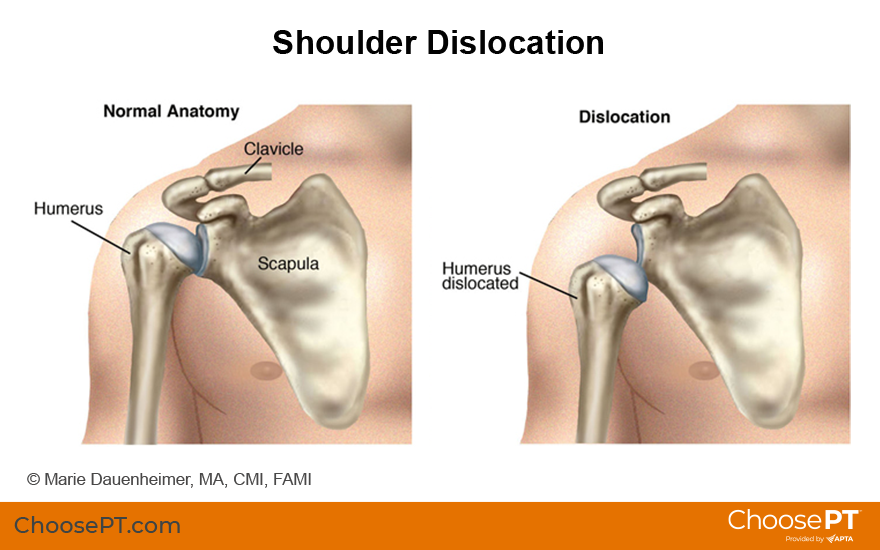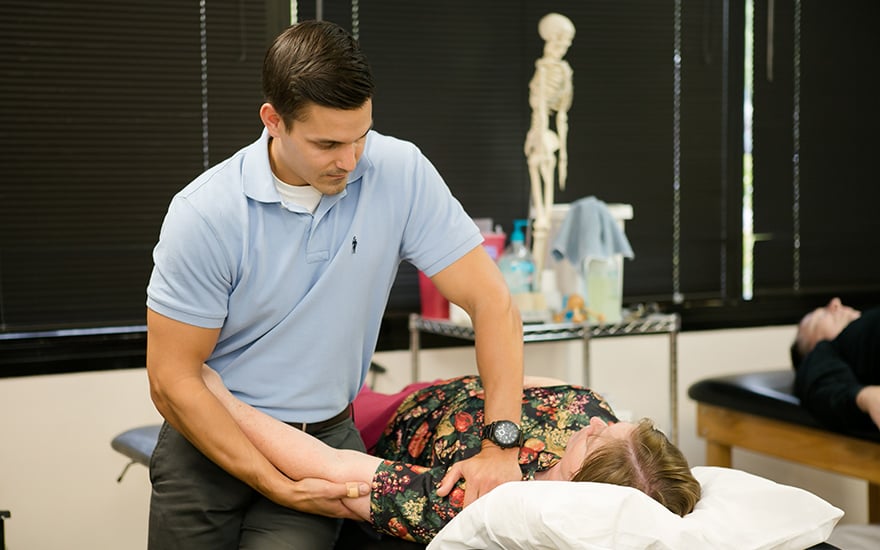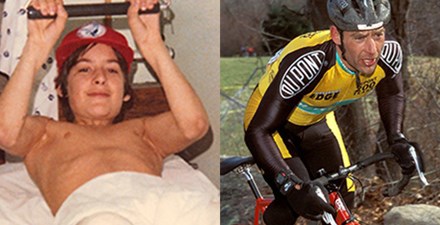Physical Therapy Guide to Shoulder Dislocation
The shoulder is the most mobile joint in the body and the easiest to dislocate. A dislocation happens when two bones that meet at a joint separate. Shoulder dislocations most often occur in contact sports. They also can result from everyday accidents like a fall. Dislocating the shoulder is a common traumatic injury for athletes, nonathletes, children, and adults. People who dislocate their shoulder usually need a health care professional to guide the joint back into place. Depending on the severity of the injury, surgery may be needed. Physical therapists help people with shoulder dislocations reduce their pain and restore strength and movement to the shoulder.
Caution: A shoulder dislocation requires immediate medical attention, especially if you experience:
- Numbness in your arm or hand
- Discoloration of your arm or hand
- A feeling of coldness in your arm
Any of these conditions may indicate injury to a nerve or blood vessel. Seek medical help immediately.
Physical therapists are movement experts. They improve quality of life through hands-on care, patient education, and prescribed movement. You can see a physical therapist directly for an evaluation and treatment without a physician's referral. The American Physical Therapy Association’s Find a PT tool can help you find one near you.*
*A referral may still be required by your insurance policy or corporate policies. Some states may limit the number of visits or treatment type without a referral.
What Is a Shoulder Dislocation?

The shoulder has three main bones. They are the:
- Clavicle (collarbone)
- Scapula (shoulder blade)
- Humerus (upper arm bone)
The top of the upper arm bone and the cup-like end of the shoulder blade fit together like a ball and socket. Falling on your shoulder or an outstretched arm can force the arm bone out of the socket. This can damage the bones, ligaments, cartilage, muscles, and tendons in the shoulder.
Joints may dislocate when a sudden impact causes the bones in the joint to shift out of place. Dislocations are among the most common traumatic injuries affecting the shoulder.
How Does It Feel?
With most shoulder dislocations, you will feel the humerus come out of the socket, followed by:
- Pain
- Inability to move the arm
- A change in appearance (the shoulder may look out of place or sunken)
In some cases, there may be additional symptoms, such as:
- Significant swelling or bruising
- Changes in skin color (paleness or purple skin)
- Numbness or tingling in the arm
If you experience any of these symptoms, seek immediate medical attention.
The arm bone usually remains "out of socket" until a physician guides it back into place. After a dislocation is moved back into place, the doctor may request an X-ray. This can help them see if you have a fracture.
In some cases, the shoulder may go back into place on its own. You might not even realize that you have dislocated your shoulder. You may feel you have only injured the shoulder.
If you have injured your shoulder and have pain, seek medical attention.
How Is It Diagnosed?
Physicians may diagnose a dislocated shoulder through a visual exam. They may seek an X-ray for a final diagnosis. After your shoulder is put back in place, you may be referred to physical therapy. A physical therapist can make sure the shoulder is stable and work with you to help reduce your pain. They can design a treatment program to restore strength and motion to the shoulder. Your physical therapist will work with your physician to ensure that you get the right treatment for your particular injury.
How Can a Physical Therapist Help?
If Surgery Is Not Needed
Your physical therapist will ask you questions about your health and injury history. They will make sure your arm is in a strong sling to protect you from reinjury. This will also help to make your shoulder more comfortable. After conducting a physical exam and learning about your goals, your physical therapist will design a shoulder rehab program for your specific needs. They will guide you through safe exercises to restore your movement and strength. They also will help you with joint awareness (the ability to sense the position and movement of your joints). They will help you develop skills to use your shoulder safely during sport or work activities. Your physical therapist also will show you how to manage your pain and reduce inflammation.
Your treatment program may include:
Range-of-motion exercises. Swelling and pain can make it hard to move your shoulder. Your physical therapist will guide you through safe exercises to restore your shoulder's full range of motion. They may also use manual (hands-on) therapy to help reduce your pain.
Strengthening exercises. Weak muscles or muscle imbalances leave your shoulder unstable and easy to reinjure. Your physical therapist will determine the right exercises for your specific needs. They can help you safely strengthen your shoulder's supporting muscles and restore it to full use.
Joint awareness and muscle retraining. Your physical therapist can teach you specialized exercises that help your shoulder muscles relearn how to respond to sudden forces or movements. They will personalize your treatment program to help you safely return to your regular activities.
Activity- or sport-specific training. Depending on your job or sport, you might need additional time working with a physical therapist to address the added demands on your shoulder. Your physical therapist will create a program that fits your needs, your specific injury, and your goals. For example, if you are a baseball pitcher, your physical therapist will work with you on throwing exercises and on improving your form.

After Surgery
If your shoulder requires surgery, your surgeon can repair the damaged tissue and help to stabilize the shoulder. After surgery, your arm will be placed in a sling, usually for 4 to 6 weeks, to minimize movement and allow healing. During this time, you won't be able to use your arm for everyday activities.
Right after surgery, your shoulder will have pain, be stiff, and might swell. Your health care team will help you manage the pain and swelling. They may show you how to apply ice to the area and teach you proper positioning.
Once you have healed enough, your physical therapist can work with you to help you recover movement and strength. This will help restore the use of your shoulder. They will tailor a treatment program based on your shoulder and goals. Treatments may range from gentle range-of-motion and strengthening exercises to activity- or sport-specific exercises. Recovery time will vary, depending on your condition and your overall health. A full return to sports, heavy lifting, and other strenuous activities may not begin until four to six months after surgery.
Caution: Your shoulder can easily get injured again. It is crucial to follow your surgeon's and physical therapist's instructions after surgery.
Physical therapy after your shoulder surgery is essential treatment. Your shoulder rehab may have four phases:
- Phase 1 (maximal protection). During the first few weeks after surgery, your shoulder is most at risk of reinjury. Your arm will be in a sling. You will likely need help or strategies to do daily tasks like bathing and dressing.
Your physical therapist will guide you through gentle exercises to move your shoulder using just the weight of your arm. They also may use manual (hands-on) therapy, such as gentle massage, cold packs, or electrical stimulation. This can help reduce pain, swelling, and stiffness. These treatments may continue as needed for up to 12 weeks. - Phase 2 (moderate protection). This phase starts about one month after surgery. Its goal is to restore more movement to your shoulder. You may use your sling less and slowly begin to do more challenging range-of-motion and strengthening exercises. In this phase, you won't use weights or bands for resistance.
Your physical therapist will give you exercises to strengthen your core and your rotator cuff muscles. These muscles provide additional support and stability to your shoulder. You may begin using your arm for daily activities. But you still must avoid any heavy lifting during physical therapy and at home. Your physical therapist may use joint mobilization techniques to help your shoulder move better. With clearance from your surgeon, you can start doing light activities, such as riding a stationary bike or walking on a treadmill. - Phase 3 (return to activity). This phase starts around three months after surgery. The goal is to restore your shoulder strength to equal that of your other shoulder. It also is a time to become aware of the position and movement of your shoulder. It needs to look and move like your uninjured shoulder (shoulder awareness). At this point, you should have full use of your arm for daily activities but should not yet do sports, yard work, or heavy tasks at home or work. Your physical therapist will change your exercises gradually as you get stronger. You might be able to start a modified weightlifting program during this phase.
- Phase 4 (return to work/sport). This phase starts about four months after surgery. Its goal is to help you get back to sports, work, and other demanding activities. Your physical therapist can design an exercise program specific to your needs. For athletes, this may include throwing and catching drills. For others, it may include practicing lifting heavy items onto shelves. They also may teach you tips to protect your shoulder while raking, shoveling, or doing housework. Your physical therapist also might recommend a shoulder brace to help you return to your activities safely.
Can This Injury or Condition Be Prevented?
Shoulder dislocations depend on how loose your shoulder is and are more likely to happen during sports or rough activities. A physical therapist can assess your shoulder and work with you to address any looseness or strength imbalances. If you are concerned or at risk for a shoulder dislocation, a physical therapist can guide you through exercises and drills. These can help strengthen your shoulder muscles and enable them to better handle physical demands.
A physical therapist also can show you positions to help prevent injury. The riskiest position is raising the arm overhead while it's turned outward, like with overhand throwing. Physical therapists help people change their movements to avoid this position and teach athletes exercises and proper body mechanics to reduce the chance of injury.
You will need to see your physical therapist if you:
- Have shoulder pain, especially during forceful activities
- Feel your shoulder is "slipping," "shifting," or "moving"
- Hear a popping sound in your shoulder with pain
If you have dislocated your shoulder before and it doesn't heal properly, you are at a greater risk for reinjury. This is also true if you don't get your full strength and usage back following injury. Research shows that many people who have had a dislocated shoulder will dislocate it again. Working with a physical therapist can help you prevent reinjury.
If you return to sports or activities too soon after a dislocation, you may be more easily hurt again. Your physical therapist will work with you to make your shoulder strong and ready for action. They will tell you when it's safe for you to return to your activities and sports. They also may recommend a shoulder brace to help ease your transition back.
What Kind of Physical Therapist Do I Need?
All physical therapists are prepared through education and experience to treat a variety of conditions or injuries. You may want to consider:
- A physical therapist who is experienced in treating athletes or people with muscle, bone, and joint (musculoskeletal) problems. Some physical therapists have a practice with an orthopedic or sports focus.
- A physical therapist who is a board-certified clinical specialist or who completed a residency or fellowship in orthopedic or sports physical therapy. This physical therapist has advanced knowledge, experience, and skills that may apply to your condition.
You can find physical therapists who have these and other credentials by using Find a PT, the online tool built by the American Physical Therapy Association to help you search for physical therapists with specific clinical expertise in your geographic area.
General tips when you're looking for a physical therapist (or any other health care provider):
- Get recommendations from family, friends, or other health care providers.
- When you contact a physical therapy clinic for an appointment, ask about the physical therapists' experience in helping people with a shoulder dislocation.
- Be prepared to describe your symptoms in as much detail as possible and say what makes your symptoms worse.
The American Physical Therapy Association believes that consumers should have access to information that can:
- Help them make health care decisions
- Prepare them for a visit with their health care provider
The following articles provide some of the best scientific evidence for the treatment of shoulder dislocation. The articles report recent research and give an overview of the standards of practice in the United States and internationally. The article titles link either to a PubMed* abstract of the article or to the free full text to read or bring with you to your health care provider.
Herman ZJ, Reddy RP, Fails A, Lin A, Popchak A. Rehabilitation and return to sport following operative and nonoperative treatment of anterior shoulder instability. Clin Sports Med. 2024;43(4):705–722. Article Summary on PubMed.
Onks C, Silvis M, Loeffert J, et al. Conservative or surgical management for that shoulder dislocation? J Fam Pract. 2021;70(2):80–85. Article Summary on PubMed.
Khiami F, Gerometta A, Loriaut P. Management of recent first-time anterior shoulder dislocations. Orthop Traumatol Surg Res. 2015;101(1 Suppl):S551–S557. Article Summary on PubMed.
Robinson CM, Seah M, Akhtar MA. The epidemiology, risk of recurrence, and functional outcome after an acute traumatic posterior dislocation of the shoulder. J Bone Joint Surg Am. 2011;93(17):1605–1613. Article Summary on PubMed.
Gaunt BW, Shaffer MA, Sauers EL, et al. The American Society of Shoulder and Elbow Therapists’ consensus rehabilitation guideline for arthroscopic anterior capsulolabral repair of the shoulder. J Orthop Sports Phys Ther. 2010;40:155–168. Article Summary on PubMed.
Godin J, Sekiya JK. Systematic review of rehabilitation versus operative stabilization for the treatment of first-time anterior shoulder dislocations. Sports Health. 2010;2:156–165. Article Summary in PubMed.
Brumitt J, Sproul A, Lentz P, et al. In-season rehabilitation of a division III female wrestler after a glenohumeral dislocation. Phys Ther Sport. 2009;10:112–117. Article Summary on PubMed.
Hovelius L, Olofsson A, Sandström B, et al. Nonoperative treatment of primary anterior shoulder dislocation in patients forty years of age and younger: a prospective twenty-five year follow up. J Bone Joint Surg Am. 2008;90:945–952. Article Summary on PubMed.
Sullivan JA, Hoffman MA, Harter RA. Shoulder joint position sense after thermal, open, and arthroscopic capsulorrhaphy for recurrent anterior instability. J Shoulder Elbow Surg. 2008;17:389–394. Article Summary on PubMed.
Robinson CM, Howes J, Murdoch H, et al. Functional outcome and risk of recurrent instability after primary traumatic anterior shoulder dislocation in young patients. J Bone Joint Surg Am. 2006;88(11):2326–2336. Article Summary on PubMed.
Millar AL, Lasheway PA, Eaton W, Christensen F. A retrospective, descriptive study of shoulder outcomes in outpatient physical therapy. J Orthop Sports Phys Ther. 2006;36:403–414. Article Summary on PubMed.
Buss DD, Lynch GP, Meyer CP, et al. Nonoperative management for in-season athletes with anterior shoulder instability. Am J Sports Med. 2004;32:1430–1433. Article Summary on PubMed.
Gibson K, Growse A, Korda L, et al. The effectiveness of rehabilitation for nonoperative management of shoulder instability: a systematic review. J Hand Ther. 2004;17:229–242. Article Summary on PubMed.
Kim SH, Ha KI, Jung MW, et al. Accelerated rehabilitation after arthroscopic Bankart repair for selected cases: a prospective randomized clinical study. Arthroscopy. 2003;19:722–731. Article Summary on PubMed.
Bottoni CR, Wilckens JH, DeBerardino TM, et al. A prospective, randomized evaluation of arthroscopic stabilization versus nonoperative treatment in patients with acute, traumatic, first-time shoulder dislocations. Am J Sports Med. 2002;30:576–580. Article Summary on PubMed.
*PubMed is a free online resource developed by the National Center for Biotechnology Information. PubMed contains millions of citations to biomedical literature, including citations in the National Library of Medicine's MEDLINE database.
Expert Review:
Sep 24, 2024
Revised:
Mar 7, 2025
Content Type: Guide
Shoulder Dislocation
PT, DPT, board-certified clinical specialist in sports physical therapy
Amanda Backe
PT
Kiera Olson
PT
James E. Zachazewski
PT, DPT, board-certified clinical specialist in sports physical therapy, on behalf of the American Academy of Sports Physical Therapy
You Might Also Like...
Patient Stories
'My Life Has Been Given Back To Me By A Physical Therapist'Jul 28, 2021
Today he is a professional cyclist and a physical therapist. But as a teenager Tim Haitz moved so awkwardly that other kids called him "swivel."
